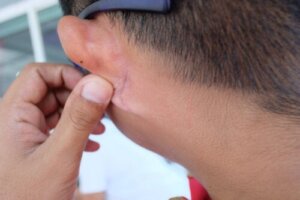Irritation Behind the Ears: What Can Cause It?


Written and verified by the doctor Leonardo Biolatto
Having an irritation behind the ears or a rash is a very common occurrence. The skin in that area tends to be affected by many different conditions.
This symptom has been associated with certain autoimmune diseases, such as psoriasis. It’s also frequently associated with viral infections such as rubella.
It’s important, then, to know which conditions can cause this problem. Differentiating the etiology of an irritation behind the ears helps to initiate appropriate treatment for diseases of concern.
What symptoms accompany irritation behind the ears?
Irritation behind the ears usually manifests as a localized rash. In most cases, only one ear is affected, although it may be bilateral.
It may be mild or patchy. It may also be a deep red or whitish color. The spots that form may be small and slightly spread out, or will converge in the same area.
It’s important to note if the irritation behind the ears is accompanied by other symptoms. For example, pain, fever, or general malaise. Similarly, it’s necessary to identify whether there has been a triggering factor, such as an allergen or irritant.
You may be interested in: Best Remedies to Treat Eczema
Possible causes of irritation behind the ears
As mentioned in the introduction, there are many conditions that can lead to irritation behind the ears. In the following sections, we’ll explain which are the most frequent and how to identify them.
1. Contact dermatitis
Contact dermatitis is an inflammatory process that occurs on the skin. It’s an allergic reaction that is triggered by a specific substance, called an allergen.
According to an Eczema publication, nickel is one of the most frequent triggers. This mineral is part of many accessories, such as earrings. Another common allergen is paraphenylenediamine, which is often present in hair dyes.
Contact dermatitis can cause irritation behind the ears. The area is usually dry and scaly, as well as intensely itchy. In order to diagnose this condition, so-called allergy tests are performed.
The main treatment is to avoid that particular allergen. Oral antihistamines may be prescribed to relieve symptoms.
You might be interested in: How to Eliminate Eczema Naturally
2. Scalp psoriasis
Psoriasis is a chronic inflammatory skin disease. In particular, scalp psoriasis can lead to irritation behind the ears. According to experts, it’s usually characterized by yellowish or whitish plaques in this area.
These are plaques where the skin is thickened and tends to produce dry scales. This is why it has an appearance similar to dandruff. As with contact dermatitis, it itches.
The diagnosis of psoriasis is complex. In some cases, a skin biopsy may be required. Treatment varies depending on the severity of the condition. If the affected area is small, it may be controlled with topical medications. For example, corticosteroids or vitamin D analogs.
Ultraviolet light therapy may also be beneficial. However, severe cases require methotrexate, cyclosporine, or biologic drugs.
3. Rubella and irritation behind the ears
Rubella is a viral infection that’s also known as German measles. As an NHS article states, it’s an uncommon infection nowadays that tends to affect children more. It’s usually self-limiting and benign.
Most cases are mild or asymptomatic. However, in pregnant women, it can lead to serious complications.
When symptoms appear, the most common one is a rash on the face. This tends to spread to other parts of the body. It can, therefore, lead to irritation behind the ears or a rash.
In addition, it’s often accompanied by cough, fever, headache and swollen glands. Conjunctivitis and rhinorrhea are also common.
In order to diagnose rubella, serological tests are usually requested. That is, an attempt is made to test for the presence of antibodies against the virus.
Fortunately, there’s a vaccine against rubella. This is important, as there’s no specific treatment for the condition.
When should you see a doctor?
Ideally, you should see a doctor whenever the irritation behind the ears is accompanied by alarming symptoms. For example, fever, malaise, tiredness, or severe itching. In addition, it’s necessary to observe whether the rash has spread to other areas.
Similarly, if purple or reddish spots appear, it’s advisable to consult a specialist. Inflammation of nearby lymph nodes is considered another warning sign.
If the rash consists of small blisters or causes pain, it’s also advisable to see a doctor. In general, any irritation behind the ears that isn’t associated with a specific trigger should be evaluated.
A common condition that isn’t usually serious
Irritation behind the ears is a fairly common occurrence. In most cases, it’s caused by an irritant or an agent that behaves like an allergen.
Fortunately, the causes are usually self-limiting or disappear with specific treatment. Because of this, it’s always advisable to consult a specialist for an accurate diagnosis and to initiate the appropriate treatment.
All cited sources were thoroughly reviewed by our team to ensure their quality, reliability, currency, and validity. The bibliography of this article was considered reliable and of academic or scientific accuracy.
- Aaron, K., Cooper, T., Warner, L., & Burton, M. (2018). Ear drops for the removal of ear wax. Cochrane Database of Systematic Reviews, (7). https://www.cochranelibrary.com/cdsr/doi/10.1002/14651858.CD012171.pub2/full
- Chovatiya, R. (2023). Atopic dermatitis (eczema). Jama, 329(3), 268-268. https://jamanetwork.com/journals/jama/fullarticle/2800427
- Mangion, S., Mackenzie, L., Roberts, M., & Holmes, A. (2023). Seborrheic dermatitis: topical therapeutics and formulation design. European Journal of Pharmaceutics and Biopharmaceutics, 185, 148-164. https://www.sciencedirect.com/science/article/abs/pii/S0939641123000292
- Michaudet, C., & Malaty, J. (2018). Cerumen impaction: diagnosis and management. American family physician, 98(8), 525-529. https://www.aafp.org/pubs/afp/issues/2018/1015/p525.html
- Mosca, M., Hong, J., Hadeler, E., Brownstone, N., Bhutani, T., & Liao, W. (2021). Scalp psoriasis: a literature review of effective therapies and updated recommendations for practical management. Dermatology and therapy, 11(3), 769-797. https://link.springer.com/article/10.1007/s13555-021-00521-z
This text is provided for informational purposes only and does not replace consultation with a professional. If in doubt, consult your specialist.








